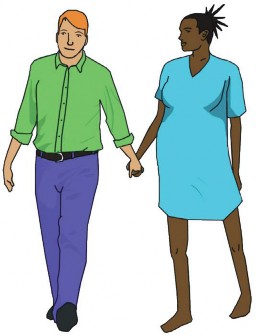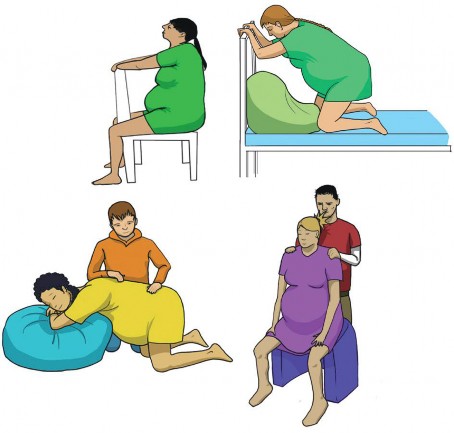Fundamentals of Midwifery: A Textbook for Students (65 page)
Read Fundamentals of Midwifery: A Textbook for Students Online
Authors: Louise Lewis

BOOK: Fundamentals of Midwifery: A Textbook for Students
12.48Mb size Format: txt, pdf, ePub
Clinical consideration



Notice next time medical assistance is requested because a woman has not progressed in her labour; note the first thing a doctor does. The doctor will palpate the abdomen to assess if the fetal head has moved down into the pelvis. The doctor is assessing whether the biparietal diameter (the
widest part of the skull) has negotiated the pelvic inlet and whether it will go through with assist-
ance or whether it is obstructed.
A reflexive, woman-centred midwife will actively find ways to encourage decent of the fetus and encourage good uterine activity through fundamental midwifery skills such as encouraging mobilisation and changing positions.
Mobilisation and positioning in labour
Applying anatomical knowledge of the pelvis and fetal skull to the birth process arms midwives with skills to help the birth process progress. The changing shape of the pelvis makes more space in the passage, while moulding of the fetal skull to reduce its diameter assists with travel- ling through the pelvis (Coad and Dunstall 2011). This pelvic change can be seen as the rhombus of Michaelis, and becomes evident on the mother’s lower back (Wickham and Sutton 2002). As the sacrum flattens and moves to give space to the passing fetus, the outer skin stretches and flattens the cleft between the buttocks. This is shown as what has been described as a purple line, seen from the anal margin and extending between the buttocks (Hobbs 1998). A recent longitudinal study concludes there is a positive correlation between the length of the purple line, cervical dilation and station of the fetal head, and it may provide a useful guide of labour progress alongside other measurements (Shepherd et al. 2010).
Midwives are now seeing the benefits of birthing balls, making ‘nests’ and utilising a platform rather than a bed to assist mobilisation. There is clear evidence that walking and adopting upright positions (see Figure 7.4) shortens the duration of labour, reduces the risk of caesarean and the need for epidural. It is therefore recommended that women are encouraged to adopt positions and be mobile in labour that suit them (Laurence et al. 2013). Figure 7.5 illustrates different positions for labour.
Optimal hormonal balance
Assessment of uterine activity is crucial in determining the progress of labour along with assess- ment of the cervical dilatation. A midwife spending time with her hand gently resting on the fundus of the uterus throughout the contractions will gain invaluable knowledge of the effec- tiveness of the uterine activity. Good, powerful and effective contractions occur due to the presence of a rich mix of hormones influencing the labour process. Oxytocin production from the posterior pituitary gland is stimulated through the pressure and stretch of the cervix sending signals through the brain. Therefore the lower the presenting part is within the pelvis, pressing down on and stretching the cervix, the more oxytocin will be produced. This will continue to accumulate through the increased intensity and act as a bio-feedback mechanism know as the Ferguson reflex (Buckley 2011).

149
150


Figure 7.4
Mobilising in labour with support from partner. Source: Reproduced with permission from J. Green.
Although this description may sound daunting to women, her body compensates through endorphin release to support the woman’s own ability. This status quo can remain if the woman is undisturbed and unstimulated, allowing her to progress through the labour phases unhin- dered. Fear however, can have a major influence on a delicately balanced cocktail of hormones. The influence of adrenaline and catecholamine can completely hinder the release of the benefi- cial hormones of oxytocin and endorphins (Buckley 2004).
Women in childbirth can be seen to become submissive when they recognise they are vulner- able; maintaining an optimal hormonal balance will ensure she submits to her own body’s natural instincts.

Activity 7.2
Think of a woman who seemed to cope well in labour without much support from others. What
emotional and behavioural characteristics did she display?
Transitional and pushing phases or ‘second stage’
With a phases view, the behaviour of the women may vary between demonstrating a strong and uncontrollable urge to push her baby out, with or without full dilatation of the cervix, to a woman having no urge to push at all with a fully dilated cervix. Both can be in transition between the first and second stages. The second stage is recognised as being from when full dilatation has been diagnosed through vaginal examination, to the birth of the baby. Some women experience an early urge to push and this can sometimes be distressing for both the woman and the midwife, impacting on their birth experience. It is however an area with little evidence yet to demonstrate its implications and inform midwifery management (Downe et al. 2004).

Figure 7.5
Different positions for labour. Source: Reproduced with permission from J. Green.

151
Women entering second stage without an urge to push are equally noteworthy. A passive delay in active pushing, if maternal and fetal wellbeing are evident can be acceptable (Frazer et al. 2000). The debate continues into how to support women in pushing out their babies. Yildirim and Beji (2008) found neonates fared better and women had shorter second stages when adopting spontaneous pushing. This is in contrast to the more traditional valsalva, closed glottis, breath-holding pushing which reduces oxygen availability at the point in labour when the fetus is most vulnerable. Hollins Martin (2009) confirms this, and the Royal College of Mid- wives (RCM) second stage guidelines (RCM 2012) also recommend encouraging women to push instinctively.
Other books
Keep the Window Open for Me by Elizabeth Ventsias
Portals Of Time by Coulter, J. Lee
Hot as Hell by Helenkay Dimon
Unveiled (Undone by Love Book 3) by Kristina Cook
Vanished Pride (The Seven Sin Sisters 4) by Beck, Paloma
I Hunt Killers Neutral Mask by Barry Lyga
The Last Voice You Hear by Mick Herron
The Taking by Dean Koontz
The Corrections by Jonathan Franzen
Sex and the Single Earl by Vanessa Kelly